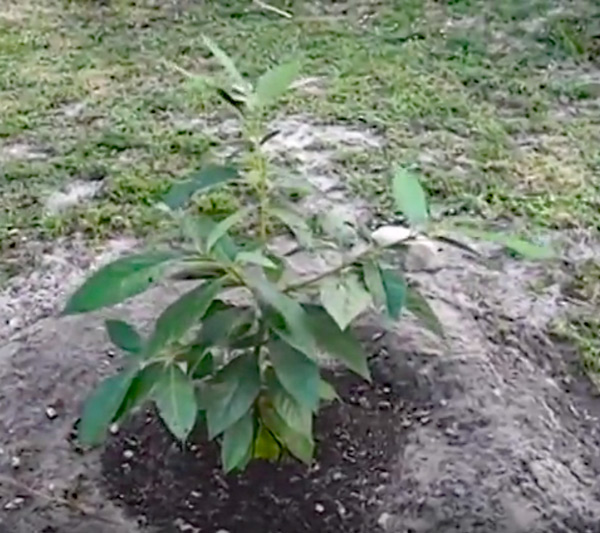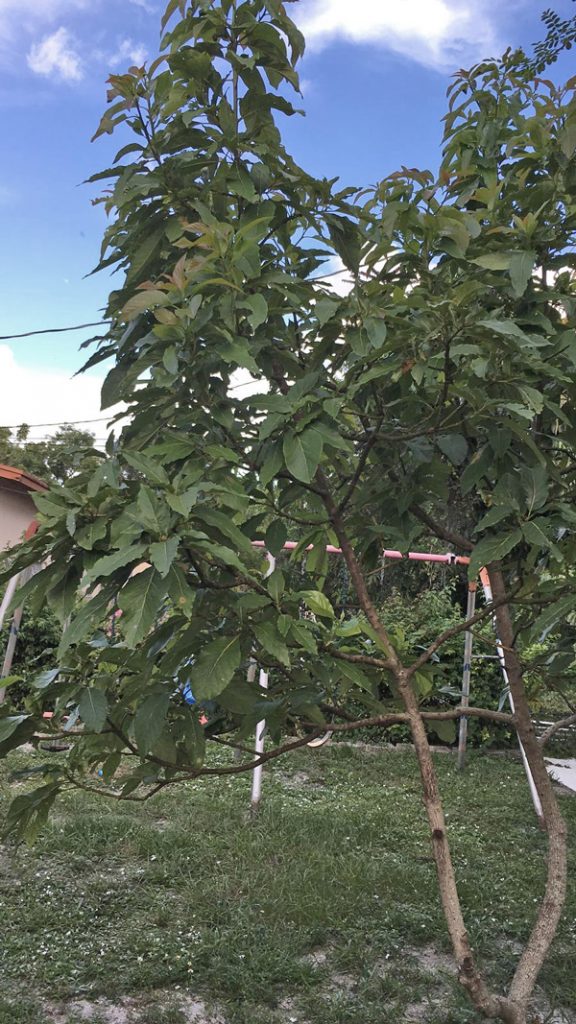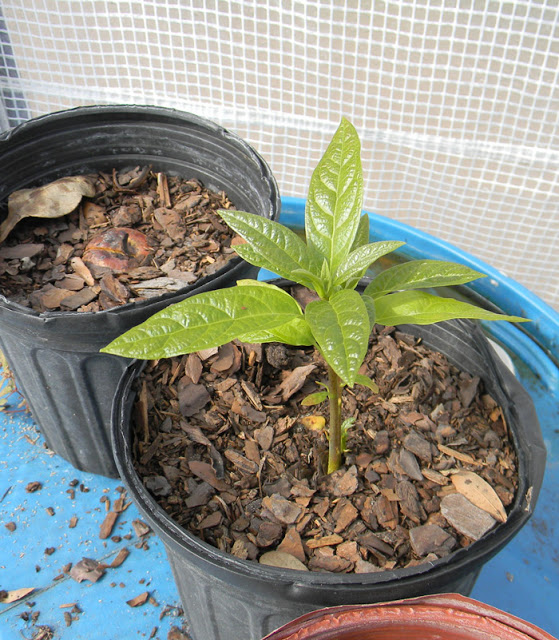How long does it take a seedling avocado to fruit? It depends on how well you care for it.
Back in 2012, I did a video tour of the Great South Florida Food Forest Project:
At 3:01, I show the little avocado tree I’d just planted.

It was a year and a half old when I planted it in the ground. I grew it from the pit of a huge-fruited Thai avocado variety I got from Rachel’s aunt.
Here it is as of September 2018, six years later:

It is over eight foot tall now and looks happy.
However, this is not a good track record for a seedling avocado and is not what you should expect. The caliper of the trunk is quite small and the tree has not fruited. It is a seven and a half-year-old tree that looks like a three year old tree.
Why?
There are a few reasons for this tree’s pokiness.
Poor Soil Slows Down Growth
South Florida is sand and limestone with very little loam or organic matter in the soil. There is no clay to speak of. The mineral content is low and the soil drains very quickly, leaching away nutrients.
Ideally, this tree would be fed every 2-3 months and kept mulched. Compost and 10-10-10 would be good enough to make it fly. Instead, it has had very little feeding so it’s doing the best it can in poor soil.
Water is Essential
Trees need regular watering to grow quickly. This tree has been only sporadically watered, relying almost solely on rainfall. With South Florida’s pronounced dry season, this means it’s not able to grow for a chunk of the year since it has to conserve resources. At this point, the roots have probably reached the water table and it’s taking care of itself, but it would be twenty foot tall by now if it had been watered earlier on. Mulching also keeps in water, reducing stress on the tree and keeping the ground cool for the feeder roots. Mulch and water are huge.
What To Do Now
Water and fertility are the two biggest factors for tree growth. An seedling avocado can fruit in as little as three years (if you threaten it), but if you put the tree in the ground and leave it to its own devices, that’s unlikely to happen. Here in Central America, there is usually plenty of rain and great soil, which means avocado trees grow very fast and bear in a few years. In South Florida, they need more love early on.
My parents are not really “gardening” people. They will care for things as the need arises, but for the most part, the trees are on their own. My advice on getting this avocado to reach for the sky and bear quickly is to:
- Clear the weeds/grass around the base by throwing down some cardboard, then mulch on top of that. Water well first, then water the cardboard layer, then mulch on top and water the mulch.
- Feed with 10-10-10 and/or compost ever three months.
- Water regularly
Those three things will make the tree thicken up and grow much larger over the next year.
If you pour effort into fruit trees early on, they will reward you later with abundant fruit in less time. My parents have always had more valuable to do than take care of fruit trees, so no criticism is implied. They mentored kids, homeschooled their children, worked with international college students, led Bible studies, worked with AWANA programs, played with grandchildren, fought for the pro-life movement and counseled couples with marital difficulty.
On top of that, Mom was widowed last year and has had to deal with the pain of that loss.
Slow fruit tree growth is rather less important. For those of you who want fruit fast, though, and have the time: water, mulch and feed!


1 comment
I’m wondering if I should plant all of these avocado starts now or wait until next year after over wintering them. I started them using your method and it worked, almost a 100% success rate. I’d plant them on the Southeastern part of the property for sure. Considering I live in zone 8b, though, the odds are stacked against me for any of these to live through our winter. Thinking I might at least acclimate them to some full sun tomorrow and see what happens. I did that with the eleven mulberries I started from cuttings today as well as a few other things. Maybe I’ll just say to heck with it and plant them out, give them some of the old 10 -10 -10 I have in the shed, water them up and see what happens. Now that I’ve seen your method works, it’s a simple matter of starting new seedlings from seed if it goes south. Also, one of my bananas bloomed and set about two hands of fruit. Pretty exciting since this is the first time we’ve ever had this happen. We might even get to eat them since there is still a lot of summer left.
Comments are closed.